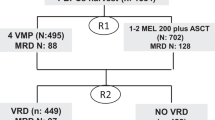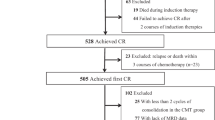Abstract
Measurable (‘minimal’) residual disease (MRD) before or after hematopoietic cell transplantation (HCT) identifies adults with AML at risk of poor outcomes. Here, we studied whether peri-transplant MRD dynamics can refine risk assessment. We analyzed 279 adults receiving myeloablative allogeneic HCT in first or second remission who survived at least 35 days and underwent 10-color multiparametric flow cytometry (MFC) analyses of marrow aspirates before and 28±7 days after transplantation. MFC-detectable MRD before (n=63) or after (n=16) transplantation identified patients with high relapse risk and poor survival. Forty-nine patients cleared MRD with HCT conditioning, whereas two patients developed new evidence of disease. The 214 MRDneg/MRDneg patients had excellent outcomes, whereas both MRDneg/MRDpos patients died within 100 days following transplantation. For patients with pre-HCT MRD, outcomes were poor regardless of post-HCT MRD status, although survival beyond 3 years was only observed among the 58 patients with decreasing but not the seven patients with increasing peri-HCT MRD levels. In multivariable models, pre-HCT but not post-HCT MRD was independently associated with overall survival and risk of relapse. These data indicate that MRDpos patients before transplantation have a high relapse risk regardless of whether or not they clear MFC-detectable disease with conditioning and should be considered for pre-emptive therapeutic strategies.
This is a preview of subscription content, access via your institution
Access options
Subscribe to this journal
Receive 12 print issues and online access
$259.00 per year
only $21.58 per issue
Buy this article
- Purchase on Springer Link
- Instant access to full article PDF
Prices may be subject to local taxes which are calculated during checkout




Similar content being viewed by others
References
Döhner H, Estey EH, Amadori S, Appelbaum FR, Büchner T, Burnett AK et al. Diagnosis and management of acute myeloid leukemia in adults: recommendations from an international expert panel, on behalf of the European LeukemiaNet. Blood 2010; 115: 453–474.
Gupta V, Tallman MS, Weisdorf DJ . Allogeneic hematopoietic cell transplantation for adults with acute myeloid leukemia: myths, controversies, and unknowns. Blood 2011; 117: 2307–2318.
Cornelissen JJ, Gratwohl A, Schlenk RF, Sierra J, Bornhäuser M, Juliusson G et al. The European LeukemiaNet AML working party consensus statement on allogeneic HSCT for patients with AML in remission: an integrated-risk adapted approach. Nat Rev Clin Oncol 2012; 9: 579–590.
Döhner H, Weisdorf DJ, Bloomfield CD . Acute myeloid leukemia. N Engl J Med 2015; 373: 1136–1152.
Goldman JM, Gale RP . What does MRD in leukemia really mean? Leukemia 2014; 28: 1131.
Campana D, Leung W . Clinical significance of minimal residual disease in patients with acute leukaemia undergoing haematopoietic stem cell transplantation. Br J Haematol 2013; 162: 147–161.
Hourigan CS, Karp JE . Minimal residual disease in acute myeloid leukaemia. Nat Rev Clin Oncol 2013; 10: 460–471.
Buckley SA, Appelbaum FR, Walter RB . Prognostic and therapeutic implications of minimal residual disease at the time of transplantation in acute leukemia. Bone Marrow Transplant 2013; 48: 630–641.
Cheson BD, Bennett JM, Kopecky KJ, Buchner T, Willman CL, Estey EH et al. Revised recommendations of the International Working Group for diagnosis, standardization of response criteria, treatment outcomes, and reporting standards for therapeutic trials in acute myeloid leukemia. J Clin Oncol 2003; 21: 4642–4649.
Vardiman JW, Thiele J, Arber DA, Brunning RD, Borowitz MJ, Porwit A et al. The revision of the World Health Organization (WHO) classification of myeloid neoplasms and acute leukemia: rationale and important changes. Blood 2009; 114: 937–951.
Grimwade D, Hills RK, Moorman AV, Walker H, Chatters S, Goldstone AH et al. Refinement of cytogenetic classification in acute myeloid leukemia: determination of prognostic significance of rare recurring chromosomal abnormalities among 5876 younger adult patients treated in the United Kingdom Medical Research Council trials. Blood 2010; 116: 354–365.
Walter RB, Gyurkocza B, Storer BE, Godwin CD, Pagel JM, Buckley SA et al. Comparison of minimal residual disease as outcome predictor for AML patients in first complete remission undergoing myeloablative or nonmyeloablative allogeneic hematopoietic cell transplantation. Leukemia 2015; 29: 137–144.
Araki D, Wood BL, Othus M, Radich JP, Halpern AB, Zhou Y et al. Allogeneic hematopoietic cell transplantation for acute myeloid leukemia: is it time to move toward a minimal residual disease-based definition of complete remission. J Clin Oncol 2016; 34: 329–336.
Walter RB, Gooley TA, Wood BL, Milano F, Fang M, Sorror ML et al. Impact of pretransplantation minimal residual disease, as detected by multiparametric flow cytometry, on outcome of myeloablative hematopoietic cell transplantation for acute myeloid leukemia. J Clin Oncol 2011; 29: 1190–1197.
Walter RB, Buckley SA, Pagel JM, Wood BL, Storer BE, Sandmaier BM et al. Significance of minimal residual disease before myeloablative allogeneic hematopoietic cell transplantation for AML in first and second complete remission. Blood 2013; 122: 1813–1821.
Fang M, Storer B, Wood B, Gyurkocza B, Sandmaier BM, Appelbaum FR . Prognostic impact of discordant results from cytogenetics and flow cytometry in patients with acute myeloid leukemia undergoing hematopoietic cell transplantation. Cancer 2012; 118: 2411–2419.
Maurillo L, Buccisano F, Del Principe MI, Del Poeta G, Spagnoli A, Panetta P et al. Toward optimization of postremission therapy for residual disease-positive patients with acute myeloid leukemia. J Clin Oncol 2008; 26: 4944–4951.
Grubovikj RM, Alavi A, Koppel A, Territo M, Schiller GJ . Minimal residual disease as a predictive factor for relapse after allogeneic hematopoietic stem cell transplant in adult patients with acute myeloid leukemia in first and second complete remission. Cancers (Basel) 2012; 4: 601–617.
Anthias C, Dignan FL, Morilla R, Morilla A, Ethell ME, Potter MN et al. Pre-transplant MRD predicts outcome following reduced-intensity and myeloablative allogeneic hemopoietic SCT in AML. Bone Marrow Transplant 2014; 49: 679–683.
Bastos-Oreiro M, Perez-Corral A, Martínez-Laperche C, Bento L, Pascual C, Kwon M et al. Prognostic impact of minimal residual disease analysis by flow cytometry in patients with acute myeloid leukemia before and after allogeneic hemopoietic stem cell transplantation. Eur J Haematol 2014; 93: 239–246.
Rossi G, Carella AM, Minervini MM, di Nardo F, Waure C, Greco MM et al. Optimal time-points for minimal residual disease monitoring change on the basis of the method used in patients with acute myeloid leukemia who underwent allogeneic stem cell transplantation: a comparison between multiparameter flow cytometry and Wilms' tumor 1 expression. Leuk Res 2015; 39: 138–143.
Zeijlemaker W, Gratama JW, Schuurhuis GJ . Tumor heterogeneity makes AML a ‘moving target’ for detection of residual disease. Cytometry B Clin Cytom 2014; 86: 3–14.
Graubert TA, Brunner AM, Fathi AT . New molecular abnormalities and clonal architecture in AML: from reciprocal translocations to whole-genome sequencing. Am Soc Clin Oncol Educ Book 2014, e334–e340.
Grimwade D, Freeman SD . Defining minimal residual disease in acute myeloid leukemia: which platforms are ready for ‘prime time’? Blood 2014; 124: 3345–3355.
Hokland P, Ommen HB, Mulé MP, Hourigan CS . Advancing the minimal residual disease concept in acute myeloid leukemia. Semin Hematol 2015; 52: 184–192.
Klco JM, Miller CA, Griffith M, Petti A, Spencer DH, Ketkar-Kulkarni S et al. Association between mutation clearance after induction therapy and outcomes in acute myeloid leukemia. JAMA 2015; 314: 811–822.
van Rhenen A, Moshaver B, Kelder A, Feller N, Nieuwint AW, Zweegman S et al. Aberrant marker expression patterns on the CD34+CD38− stem cell compartment in acute myeloid leukemia allows to distinguish the malignant from the normal stem cell compartment both at diagnosis and in remission. Leukemia 2007; 21: 1700–1707.
Goardon N, Marchi E, Atzberger A, Quek L, Schuh A, Soneji S et al. Coexistence of LMPP-like and GMP-like leukemia stem cells in acute myeloid leukemia. Cancer Cell 2011; 19: 138–152.
Gerber JM, Smith BD, Ngwang B, Zhang H, Vala MS, Morsberger L et al. A clinically relevant population of leukemic CD34(+)CD38(−) cells in acute myeloid leukemia. Blood 2012; 119: 3571–3577.
Terwijn M, Zeijlemaker W, Kelder A, Rutten AP, Snel AN, Scholten WJ et al. Leukemic stem cell frequency: a strong biomarker for clinical outcome in acute myeloid leukemia. PLoS One 2014; 9: e107587.
Bradbury C, Houlton AE, Akiki S, Gregg R, Rindl M, Khan J et al. Prognostic value of monitoring a candidate immunophenotypic leukaemic stem/progenitor cell population in patients allografted for acute myeloid leukaemia. Leukemia 2015; 29: 988–991.
Acknowledgements
Research reported in this publication was supported by a grant from the National Cancer Institute/National Institutes of Health (NCI/NIH: P30-CA015704) and a fellowship training grant from the National Heart, Lung, and Blood Institute/NIH (T32-HL007093; to ABH). RBW is a Leukemia & Lymphoma Society Scholar in Clinical Research. The authors thank the physicians and nurses of the HCT teams, the staff in the Long Term Follow-Up Program at the Fred Hutchinson Cancer Research Center, the Hematopathology Laboratory at the University of Washington, and our patients for assisting with our research protocols.
Author information
Authors and Affiliations
Corresponding author
Ethics declarations
Competing interests
The authors declare no conflict of interest.
Rights and permissions
About this article
Cite this article
Zhou, Y., Othus, M., Araki, D. et al. Pre- and post-transplant quantification of measurable (‘minimal’) residual disease via multiparameter flow cytometry in adult acute myeloid leukemia. Leukemia 30, 1456–1464 (2016). https://doi.org/10.1038/leu.2016.46
Received:
Revised:
Accepted:
Published:
Issue Date:
DOI: https://doi.org/10.1038/leu.2016.46
This article is cited by
-
Measurable residual disease (MRD)-testing in haematological and solid cancers
Leukemia (2024)
-
Comparison of reduced intensity and nonmyeloablative conditioning for adults with acute myeloid leukemia undergoing allogeneic hematopoietic cell transplantation in first or second remission
Bone Marrow Transplantation (2023)
-
Factors predicting survival following alloSCT in patients with therapy-related AML and MDS: a multicenter study
Bone Marrow Transplantation (2023)
-
Overcoming relapse: prophylactic or pre-emptive use of azacitidine or FLT3 inhibitors after allogeneic transplantation for AML or MDS
International Journal of Hematology (2023)
-
Pre-emptive and prophylactic donor lymphocyte infusion following allogeneic stem cell transplantation
International Journal of Hematology (2023)



